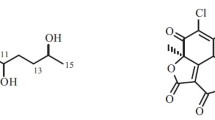Abstract
The white pine blister rust caused by Cronartium ribicola is a severe disease of Pinus armandii Franch in Sichuan Province, China. A mycoparasite was isolated from aeciospore piles of C. ribicola and identified as Pestalotipsis sp. The chemical constituents were investigated and nine new polyketides, named pestalotic acids A-I (1–9), were isolated from solid fermentation products of Pestalotiopsis sp. cr014. Their structures were elucidated by extensive spectroscopic methods, including 1D- and 2D- NMR, HR-MS experiments. Compounds 2–5 and 7–9 exhibited strong antibacterial activities in vitro against five plant pathogens, with minimum inhibitory concentration values of 0.78–100 µg/mL.


Similar content being viewed by others
References
Araud-Razou I, Vasse J, Montrozier H, Tchebar C, Trigalet A (1998) Detection and visualization of the major acidic exopolysaccharide of Ralstonia solanacearum and its role in tomato root infection and vascular colonization. Eur J Plant Pathol 104:795–809
Copping LG, Duke SO (2007) Natural products that have been used commercially as crop protection agents. Pest Manag Sci 63:524–554
Ding G, Li Y, Fu S, Liu S, Wei J, Che Y (2009) Ambuic acid and torreyanic acid derivatives from the endolichenic fungus Pestalotiopsis sp. J Nat Prod 72:182–186
Genin S, Denny TP (2012) Pathogenomics of the Ralstonia solanacearum species complex. Annu Rev Phytopathol 50:67–89
Lee J, Stroble G, Lobkovsky E, Clardy J (1996) Torreyanic acid: a selectively cytotoxic quinone dimer from the endophytic fungus Pestalotiopsis microspore. J Org Chem 61:3232–3233
Li JY, Harper JK, Grant DM, Tombe BO, Bashyal B, Hess WM, Strobel GA (2001) Ambuic acid, a highly functionalized cyclohexenone with antifungal activity from Pestalotiopsis spp. and Monochaetia sp. Phytochemistry 56:463–468
Li J, Yang YH, Zhou L, Cheng LJ, Chen YH (2014) Destructive effects of a mycoparasite Trichoderma atroviride SS003 on aeciospores of Cronartium ribicola. J Phytopathol 162:396–401
Matsuda K, Toyoda H, Nishio H, Nishida T, Dohgo M, Bingo M, Matsuda Y, Yoshida S, Harada S, Tanaka H (1998) Control of the bacterial wilt of tomato plants by a derivative of 3-indolepropionic acid based on selective actions on Ralstonia solanacearum. J Agric Food Chem 46:4416–4419
Peeters N, Guidot A, Vailleau F, Valls M (2013) Ralstonia solanacearum, a widespread bacterial plant pathogen in the post-genomic era. Mol Plant Pathol 14:651–662
Savary S, Ficke A, Aubertot JN, Hollier C (2012) Crop losses due to diseases and their implications for global food production losses and food security. Food Secur 4:519–537
Singh S, Gautam RK, Singh DR, Sharma TVRS, Sakthivel K, Roy SD (2015) Genetic approaches for mitigating losses caused by bacterial wilt of tomato in tropical islands. Eur J Plant Pathol 143:205–221
Strobel G, Daisy B, Castillo U, Harper J (2004) Natural products from endophytic microorganisms. J Nat Prod 67:257–268
Tereshuck ML, Riera MVQ, Castro GR, Abdala LR (1997) Antimicrobial activity of flavonoids from leaves of Tagetes minuta. J Ethnopharmacol 56:227–232
Xie J, Li J, Yang YH, Chen YH, Zhao PJ (2014) Two new ambuic acid analogs from Pestalotiopsis sp. Cr013. Phytochemistry Lett 10:291–294
Xu J, Ebada SS, Proksch P (2010) Pestalotiopsis a highly creative genus: chemistry and bioactivity of secondary metabolites. Fungal Divers 44:15–31
Acknowledgments
This work was supported by the National Basic Research Program of China (973 program 2013CB127505), the National Natural Science Foundation of China (31170061 and 31360028), and the Applied Basic Research Foundation of Yunnan Province (2013FA018). We acknowledge the Department of Instrumental Analysis of Kunming Institute of Botany for measuring the optical rotations, UV, NMR and mass spectra.
Author information
Authors and Affiliations
Corresponding author
Ethics declarations
Conflict of interest
Authors declare no competing financial interests associated with the manuscript exist.
Rights and permissions
About this article
Cite this article
Li, J., Xie, J., Yu, FX. et al. Pestalotic acids A-I, antibacterial ambuic acid analogues, from a mycoparasite (Pestalotipsis sp. cr014) of Cronartium ribicola . Arch. Pharm. Res. (2016). https://doi.org/10.1007/s12272-016-0837-2
Received:
Accepted:
Published:
DOI: https://doi.org/10.1007/s12272-016-0837-2




